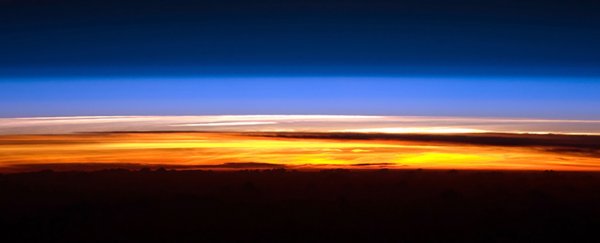Ozone is a chemical consisting of three oxygen atoms bonded in a V-like shape. It occurs both naturally through reactions in the atmosphere and as a pollutant released by transport and industrial activities.
Elevated concentrations of the molecule close to the ground put humans at greater risk of respiratory illness, and potentially increase the chances of an early death. It has also been associated with the development of autism symptoms in genetically susceptible children.
Yet ozone isn't all bad news. In higher concentrations as a layer far up in the stratosphere, roughly 10 to 50 kilometres (6 to 30 miles) overhead, this same molecule is a lifesaver. It absorbs between 90 and 99 percent of the ultraviolet radiation that reaches Earth from the Sun, preventing it from damaging living things below.
What is the hole in the ozone layer?
In 1985, scientists at the Halley IV and Faraday Research Stations in Antarctica announced ozone concentrations had been dipping significantly over the icy continent each spring since the early 1970s.
Since then, typical concentrations over the continent have depleted by as much as 70 percent, creating an exceptional thinning (or 'hole'), stretching as far as 16.3 million square kilometres (6.3 million square miles).
The oxygen atoms making up ozone react easily with chemicals made up of hydrogen, nitrogen, chlorine, or bromine. Small organic compounds called chlorofluorocarbons (CFCs) are particularly efficient at destroying ozone molecules in the presence of sunlight.
Produced in commercial quantities around the world in the middle of the 20th century and used as a solvent and a coolant in refrigeration, emissions of CFCs by humans became concentrated via polar winds over Antarctica during the winter months.
By clinging to the surfaces of stratospheric cloud particles, CFC molecules steadily reduced concentrations of ozone as spring and summer sunshine fuelled the reaction.
What's more, since replacement ozone was prevented from flowing in from the tropics by strong winds, ozone concentrations slowly declined over a wide area, allowing increased levels of UV light to shine through and potentially damage the biosphere.
What happened to the hole in the ozone layer?
In 1989, the Montreal Protocol on Substances that Deplete the Ozone Layer came into force, with signatory nations aiming to phase out the production, use and import of CFCs responsible for the ozone's hole.
The agreement largely succeeded at ending most industrial processes responsible for CFC emissions, and since then, there has been a steady decrease in the seasonal declines of ozone over Antarctica. In 2019, the thinning was the smallest annual peak measured since the early 1980s.
The Montreal Protocol is generally applauded as a success story, and yet in spite of its historical strength, scientists have recently detected ozone-depleting pollutants in some parts of the world, potentially slowing the rate at which the hole can repair and putting all our hard work at risk.
All topic-based articles are determined by fact checkers to be correct and relevant at the time of publishing. Text and images may be altered, removed, or added to as an editorial decision to keep information current.
